Phrynoponera gabonensis
| Phrynoponera gabonensis | |
|---|---|

| |
| Scientific classification | |
| Kingdom: | Animalia |
| Phylum: | Arthropoda |
| Class: | Insecta |
| Order: | Hymenoptera |
| Family: | Formicidae |
| Subfamily: | Ponerinae |
| Tribe: | Ponerini |
| Genus: | Phrynoponera |
| Species: | P. gabonensis |
| Binomial name | |
| Phrynoponera gabonensis (André, 1892) | |
| Synonyms | |
| |
Phrynoponera gabonensis is the most common, widely distributed and frequently encountered member of the genus. Specimens are usually retrieved from leaf litter samples but also occur in pitfall traps. The species is known to nest in and under rotten wood, in compacted soil and in termitaries.
Identification
Keys including this Species
Distribution
Known from Ivory Coast, Ghana, Guinea, Cameroon, Gabon, Central African Republic, Democratic Republic of Congo, Angola, Sudan, Uganda, Kenya and Mozambique.
Latitudinal Distribution Pattern
Latitudinal Range: 6.417222222° to -19.53333°.
| North Temperate |
North Subtropical |
Tropical | South Subtropical |
South Temperate |
- Source: AntMaps
Distribution based on Regional Taxon Lists
Afrotropical Region: Cameroun, Central African Republic, Democratic Republic of Congo, Gabon (type locality), Guinea, Ivory Coast, Kenya, Mozambique, Rwanda, Uganda.
Distribution based on AntMaps
Distribution based on AntWeb specimens
Check data from AntWeb
Countries Occupied
| Number of countries occupied by this species based on AntWiki Regional Taxon Lists. In general, fewer countries occupied indicates a narrower range, while more countries indicates a more widespread species. |

|
Estimated Abundance
| Relative abundance based on number of AntMaps records per species (this species within the purple bar). Fewer records (to the left) indicates a less abundant/encountered species while more records (to the right) indicates more abundant/encountered species. |

|
Biology
Association with Other Organisms
 Explore: Show all Associate data or Search these data. See also a list of all data tables or learn how data is managed.
Explore: Show all Associate data or Search these data. See also a list of all data tables or learn how data is managed.
- This species is a associate (details unknown) for the fungus Corydceps amoene-roseus (a associate (details unknown)) (Quevillon, 2018).
Castes
Males of this species, originated in two series with the data: Ghana: Tafo, 11.vi.1970 and 26.vi.1970; respectively “in wet-rotten log” and “wet-rotten branch in leaf litter” (B. Bolton). In the first series the male was collected with both workers and queen, in the second with workers. Both are in The Natural History Museum and one specimen is in Los Angeles County Museum of Natural History. (Bolton and Fisher 2008)
Worker
Images from AntWeb
   
| |
| Worker. Specimen code casent0178201. Photographer April Nobile, uploaded by California Academy of Sciences. | Owned by NHMUK, London, UK. |
   
| |
| Worker. Specimen code casent0178228. Photographer April Nobile, uploaded by California Academy of Sciences. | Owned by CAS, San Francisco, CA, USA. |
   
| |
| Syntype of Phrynoponera gabonensis. Worker. Specimen code casent0178601. Photographer April Nobile, uploaded by California Academy of Sciences. | Owned by LACM, Los Angeles, CA, USA. |
  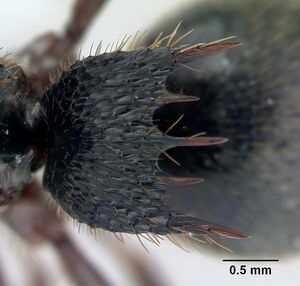 
| |
| Queen (alate/dealate). Specimen code casent0401945. Photographer April Nobile, uploaded by California Academy of Sciences. | Owned by CAS, San Francisco, CA, USA. |
  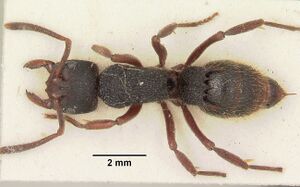 
| |
| Worker. Specimen code sam-hym-c002828. Photographer Michele Esposito, uploaded by California Academy of Sciences. | Owned by SAMC, Cape Town, South Africa. |
   
| |
| Worker. Specimen code sam-hym-c007965. Photographer April Nobile, uploaded by California Academy of Sciences. | Owned by SAMC, Cape Town, South Africa. |
    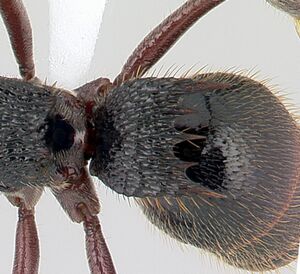 
| |
| Worker. Specimen code casent0178229. Photographer April Nobile, uploaded by California Academy of Sciences. | Owned by CAS, San Francisco, CA, USA. |
  
| |
| Worker. Specimen code casent0411299. Photographer April Nobile, uploaded by California Academy of Sciences. | Owned by CAS, San Francisco, CA, USA. |

| |
| Specimen code casent0107649. . | |
Queen
Images from AntWeb
    
| |
| Queen (alate/dealate). Specimen code casent0094797. Photographer April Nobile, uploaded by California Academy of Sciences. | Owned by CAS, San Francisco, CA, USA. |
Male
  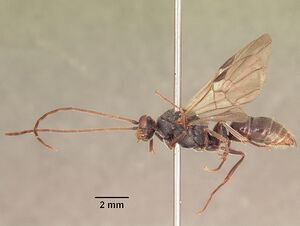     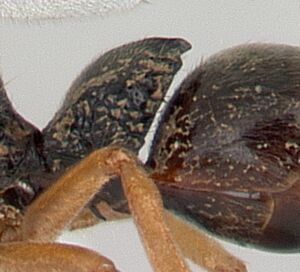   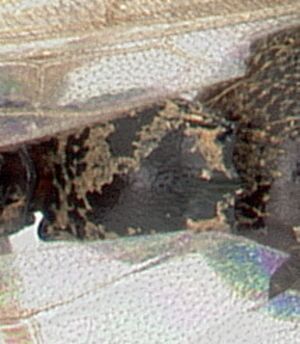    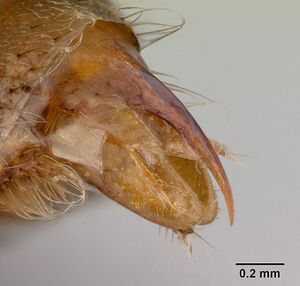  
| |
| . | |
Nomenclature
The following information is derived from Barry Bolton's Online Catalogue of the Ants of the World.
- gabonensis. Bothroponera gabonensis André, 1892a: 50 (w.) GABON. Stitz, 1910: 130 (q.). Bolton & Fisher, 2008b: 39 (m.). Combination in Pachycondyla (Bothroponera): Emery, 1901a: 45; in Phrynoponera: Wheeler, W.M. 1920: 53. Senior synonym of esta, fecunda, robustior, striatidens, umbrosa: Brown, 1950e: 246; of armata, heterodus: Bolton & Fisher, 2008b: 43.
- striatidens. Pachycondyla (Bothroponera) gabonensis var. striatidens Santschi, 1914d: 315, fig. 4 (w.) CAMEROUN. Combination in Phrynoponera: Wheeler, W.M. 1922a: 78. Junior synonym of gabonensis: Brown, 1950e: 246; Bolton & Fisher, 2008b: 43.
- armata. Pachycondyla (Bothroponera) armata Santschi, 1919h: 82 (w.) DEMOCRATIC REPUBLIC OF CONGO. Combination in Phrynoponera: Wheeler, W.M. 1922a: 773. Junior synonym of gabonensis: Bolton & Fisher, 2008b: 43.
- robustior. Pachycondyla (Bothroponera) gabonensis var. robustior Santschi, 1919h: 82 (w.) DEMOCRATIC REPUBLIC OF CONGO. Combination in Phrynoponera: Wheeler, W.M. 1922a: 774. Junior synonym of gabonensis: Brown, 1950e: 246.
- esta. Phrynoponera gabonensis var. esta Wheeler, W.M. 1922a: 77 (w.q.) DEMOCRATIC REPUBLIC OF CONGO. Junior synonym of gabonensis: Brown, 1950e: 246.
- fecunda. Phyrnoponera gabonensis var. fecunda Wheeler, W.M. 1922a: 78 (w.q.) DEMOCRATIC REPUBLIC OF CONGO. Junior synonym of gabonensis: Brown, 1950e: 246.
- heterodus. Phrynoponera heterodus Wheeler, W.M. 1922a: 78 (q.) DEMOCRATIC REPUBLIC OF CONGO. Junior synonym of gabonensis: Bolton & Fisher, 2008b: 43.
- umbrosa. Phrynoponera gabonensis var. umbrosa Wheeler, W.M. 1922a: 78 (w.) DEMOCRATIC REPUBLIC OF CONGO. Junior synonym of gabonensis: Brown, 1950e: 246.
Unless otherwise noted the text for the remainder of this section is reported from the publication that includes the original description.
Description
Worker
Bolton and Fisher (2008) - TL 7.8-10.2, HL 1.76-2.20, HW 1.76-2.12, CI 95-102, SL 1.38-1.76, SI 78-85, PW 1.44-1.76, WL 2.56-3.04, maximum diameter of eye 0.36–0.46, OI 19–23 (25 measured).
Mandible colour usually red, but quite commonly brownish red, brown or black, with all intermediate shades known; in teneral workers the mandibles may be yellow. Mandible usually smooth with scattered pits but many samples show varying degrees of very fine striate sculpture on the apical half. Less commonly, more than half the mandible may be striate and sometimes the entire mandible is finely striate everywhere. Mandible usually with 4 or 5 teeth but some samples have 6 or 7 (7 in holotype); the maximum number recorded is 8 and some workers have different numbers of teeth on each mandible. Anterior clypeal margin with a conspicuous concavity medially and on each side of the concavity there is a blunt tooth or tooth-like prominence. Head capsule usually black but with the anterior portion and antennae brown to red. Sometimes the antennae are dark brown to blackish and sometimes the head capsule is entirely black or entirely reddish. Cephalic sculpture consists of costulae that may be uniform or broken, variable in coarseness of development, sometimes roughly longitudinal near the midline but otherwise radiating outwards and backwards on each side of the midline. Dorsal mesonotum usually reticulate-rugose, but frequently the rugular cross-meshes are weakened so that the sculpture has an overall longitudinal direction. Mesosoma generally black but varying patches or areas of red are frequent. Legs usually brown to red and distinctly lighter than the mesosoma, but in some they may be blackish. Gastral tergites 1–2 show much variation in density and intensity of sculpture. In the most weakly sculptured examples the tergites are glossy and almost smooth, only vaguely superficially reticulate-punctate. From this pattern the reticulate-punctate sculpture increases in density and intensity, so that the surfaces become entirely covered in a sharply defined reticulate-punctate blanket and the tergal surfaces become less glossy. At any point in this sequence of increasing density of punctation small costulae may appear, first around the setal pits then more extensively between the pits. The costulae increase in density and extent, and become more obviously longitudinal and parallel, until in the most coarsely sculptured series the sculpture of the first and second gastral tergites is entirely of dense longitudinal costulae upon a reticulatepunctate ground-sculpture. The third gastral tergite is usually just reticulate-punctate, but in the most densely sculptured workers some longitudinal costulae may also appear on this sclerite. In general the form of the gastral sculpture is only slightly variable within nest samples, but the changes in sculpture outlined form a gradual and continuous sequence in which there are no obvious breaks. Posterior margins of the gastral sclerites are usually reddish (yellowish in tenerals), but in some the sclerites are entirely black.
Type Material
Bolton and Fisher (2008): Holotype worker, GABON: no loc. (Mocquerys) (MNHN) [examined].
Pachycondyla (Bothroponera) gabonensis var. striatidens Holotype worker, CAMEROUN: Victoria (Silvestri) (DEUN) [not seen; see note].
Pachycondyla (Bothroponera) armata Holotype worker, DEMOCRATIC REPUBLIC OF CONGO: Kitempuka (Gérard) (NHMB) [examined].
Pachycondyla (Bothroponera) gabonensis var. robustior Syntype worker, DEMOCRATIC REPUBLIC OF CONGO: Banalia, 12.xii., no. 96 (Bequaert) (NHMB) [examined].
Phrynoponera gabonensis var. esta Syntype workers and queen, DEMOCRATIC REPUBLIC OF CONGO: Medje, stomach Bufo superciliaris (H.O. Lang); Medje, 27°15’E, 2°25’N, stomach Bufo tuberosus (no collector’s name, presumably Lang or Lang & Chapin) (AMNH, MCZC, LACM) [examined].
Phyrnoponera gabonensis var. fecunda Syntype workers and queen, DEMOCRATIC REPUBLIC OF CONGO: Akenge, 26°50’E, 2°55’N, stomach Bufo polycercus, Bufo funereus (H.O. Lang) (AMNH, MCZC, LACM) [examined].
Phrynoponera gabonensis var. umbrosa Syntype workers, DEMOCRATIC REPUBLIC OF CONGO: Medje, stomach Bufo polycercus (H.O. Lang) (AMNH, MCZC) [examined].
Phrynoponera heterodus Holotype queen, DEMOCRATIC REPUBLIC OF CONGO: Stanleyville, 25°10’E, 0°30’N (Lang & Chapin) (AMNH) [examined].
Note. The holotype worker of striatidens is not in NHMB and therefore must be assumed to be in Silvestri’s collection at DEUN, which is not currently available for examination. Among the large quantity of material examined the area of the mandible with striation was extremely variable, from entirely absent to complete, and the intensity of striation, when present, was also variable, thus Brown’s synonymy of the name is confirmed here.
References
- André, E. 1892a. Matériaux myrmécologiques. Rev. Entomol. (Caen) 11: 45-56. (page 50, worker described)
- Brown, W. L., Jr. 1950g. Morphological, taxonomic, and other notes on ants. Wasmann J. Biol. 8: 241-250 (page 246, Senior synonym of esta, fecunda, robustior, striatidens and umbrosa)
- Emery, C. 1901b. Notes sur les sous-familles des Dorylines et Ponérines (Famille des Formicides). Ann. Soc. Entomol. Belg. 45: 32-54 (page 45, Combination in Pachycondyla (Bothroponera))
- Esteves, F.A., Fisher, B.L. 2021. Corrieopone nouragues gen. nov., sp. nov., a new Ponerinae from French Guiana (Hymenoptera, Formicidae). ZooKeys 1074, 83–173 (doi:10.3897/zookeys.1074.75551).
- Nsengimana, V., Hagenimana, T., Barakagwira, J., de Dieu Nsenganeza, J., Iradukunda, S. C., Majyambere, M., Kizungu, O. B., Nkundimana, A., Umutoni, D., Fabrice, R., Cyubahiro, B., Kouakou, L. M., Kolo, Y., Anale, J. S., Gómez, K., Dekoninck, W. 2023. Checklist of ant (Hymenoptera: Formicidae) species from Nyungwe Tropical Rain Forest, south-western Rwanda. Journal of East African Natural History 111(2), 69-81 (doi:10.2982/028.111.0203).
- Bolton, B. and B. L. Fisher. 2008. The Afrotropical ponerine ant genus Phrynoponera Wheeler. Zootaxa. 1892:35-52. PDF
- Stitz, H. 1910. Westafrikanische Ameisen. I. Mitt. Zool. Mus. Berl. 5: 125-151 (page 130, queen described)
- Troya, A., Marcineiro, F., Lattke, J.E. & Longino, J. 2022. Igaponera curiosa, a new ponerine genus (Hymenoptera: Formicidae) from the Amazon. European Journal of Taxonomy 823: 82–101 (doi:10.5852/ejt.2022.823.1817).
- Wheeler, W. M. 1920. The subfamilies of Formicidae, and other taxonomic notes. Psyche (Camb.) 27: 46-55 (page 53, Combination in Phrynoponera)
References based on Global Ant Biodiversity Informatics
- André E. 1892. Matériaux myrmécologiques. Rev. Entomol. (Caen) 11: 45-56.
- Belshaw R., and B. Bolton. 1994. A survey of the leaf litter ant fauna in Ghana, West Africa (Hymenoptera: Formicidae). Journal of Hymenoptera Research 3: 5-16.
- Belshaw R., and B. Bolton. 1994. A survey of the leaf litter ant fauna in Ghana, West Africa (Hymenoptera: Formicidae). Journal of Hymenoptera Research. 3: 5-16.
- Bernard F. 1953. La réserve naturelle intégrale du Mt Nimba. XI. Hyménoptères Formicidae. Mémoires de l'Institut Français d'Afrique Noire 19: 165-270.
- Bolton B., and B. L. Fisher. 2008. The Afrotropical ponerine ant genus Phrynoponera Wheeler (Hymenoptera: Formicidae). Zootaxa 1892: 35-52.
- Bolton, B. and B.L. Fisher. 2008. Afrotropical ants of the ponerine genera Centromyrmex Mayr, Promyopias Santschi gen. rev. and Feroponera gen. n., with a revised key to genera of African Ponerinae (Hymenoptera: Formicidae). Zootaxa 1929:1-37.
- Braet Y., and B. Taylor. 2008. Mission entomologique au Parc National de Pongara (Gabon). Bilan des Formicidae (Hymenoptera) recoltes. Bulletin S. R. B. E./K.B.V.E. 144: 157-169.
- Eidmann H. 1944. Die Ameisenfauna von Fernando Poo. 27. Beitrag zu den Ergebnissen der Westafrika-Expedition. Zool. Jahrb. Abt. Syst. Ökol. Geogr. Tiere 76: 413-490.
- Garcia F.H., Wiesel E. and Fischer G. 2013.The Ants of Kenya (Hymenoptera: Formicidae)Faunal Overview, First Species Checklist, Bibliography, Accounts for All Genera, and Discussion on Taxonomy and Zoogeography. Journal of East African Natural History, 101(2): 127-222
- Hita Garcia, F., G. Fischer, M.K. Peters, R.R. Snelling and H.W. Wagele. 2009. A preliminary checklist of the ants (Hymenoptera: Formicidae) of Kakamega Forest (Kenya). Journal of East African Natural HIstory 98(2): 147-165.
- IZIKO South Africa Museum Collection
- Lévieux J. 1972. Les fourmis de la savane de Lamto (Côte d'Ivoire): éléments de taxonomie. Bulletin de l'Institut Fondamental d'Afrique Noire. Série A. Sciences Naturelles 34: 611-654.
- Menozzi C. 1942. Formiche dell'isola Fernando Poo e del territorio del Rio Muni (Guinea Spagnola). 24. Beitrag zu den wissenschaftlichen Ergebnissen der Forschungsreise H. Eidmann nach Spanisch-Guinea 1939 bis 1940. Zoologischer Anzeiger 140: 164-182.
- Nsengimana V., K. A. Beth, F. Frederic, K. M. M. Lombart, D. Wouter, and N. Donat. 2018. Use of soil and litter ants (Hymenoptera: Formicidae) as biological indicators of soil quality under different land uses in Southern Rwanda. Environmental Entomology 47(6): 1394-1401.
- Ross S. R. P. J., F. Hita Garcia, G. Fischer, and M. K. Peters. 2018. Selective logging intensity in an East African rain forest predicts reductions in ant diversity. Biotropica 1-11.
- Weber N. A. 1943. The ants of the Imatong Mountains, Anglo-Egyptian Sudan. Bulletin of the Museum of Comparative Zoology 93: 263-389.
- Wheeler W. M. 1922. Ants of the American Museum Congo expedition. A contribution to the myrmecology of Africa. II. The ants collected by the American Museum Congo Expedition. Bulletin of the American Museum of Natural History 45: 39-269.
- Yeo K., and A. Hormenyo. 2007. A Rapid Survey of Ants in Ajenjua Bepo and Mamang River Forest Reserves, Eastern Region of Ghana. Pp 27-29. In McCullough, J., P. Hoke, P. Naskrecki, and Y. Osei-Owusu (eds.). 2008. A Rapid Biological Assessment of the Ajenjua Bepo and Mamang River Forest Reserves, Ghana. RAP Bulletin of Biological Assessment 50. Conservation International, Arlington, VA, USA.

